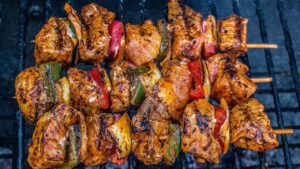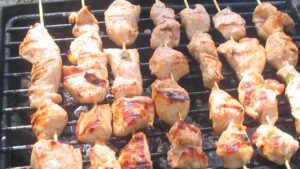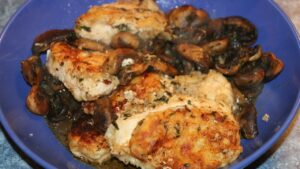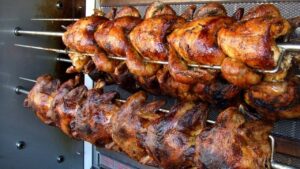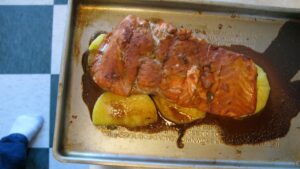What is Roasting?
Roasting is a method of dry heat cooking that involves surrounding food with hot air from an oven, open flame, or other heat source, which cooks it uniformly on all sides.
The Maillard reaction, which imparts roasted food with a crisp, browned exterior and rich, caramelized flavors, is one of the primary reasons to use this cooking method.
Roasting is a simple and uncomplicated method, requiring minimal effort beyond monitoring the heat to ensure the food cooks perfectly.
Key Takeaways
- Roasting is a method of slow cooking that uses diffused, indirect heat to cook its ingredients.
- It is a dry-heat cooking technique where hot air surrounds the food until it is evenly cooked on all sides.
- By caramelizing and browning the food’s surface, roasting is frequently used to improve the flavour of a dish.
- By caramelizing and browning the food’s surface, this cooking technique enables flavour to emerge as the dish’s primary component.
- A flavourful crust is produced during roasting, which calls for a higher temperature.
- Beyond a basic roaster pan, roasting does not call for any special cookware.
Understanding Roasting
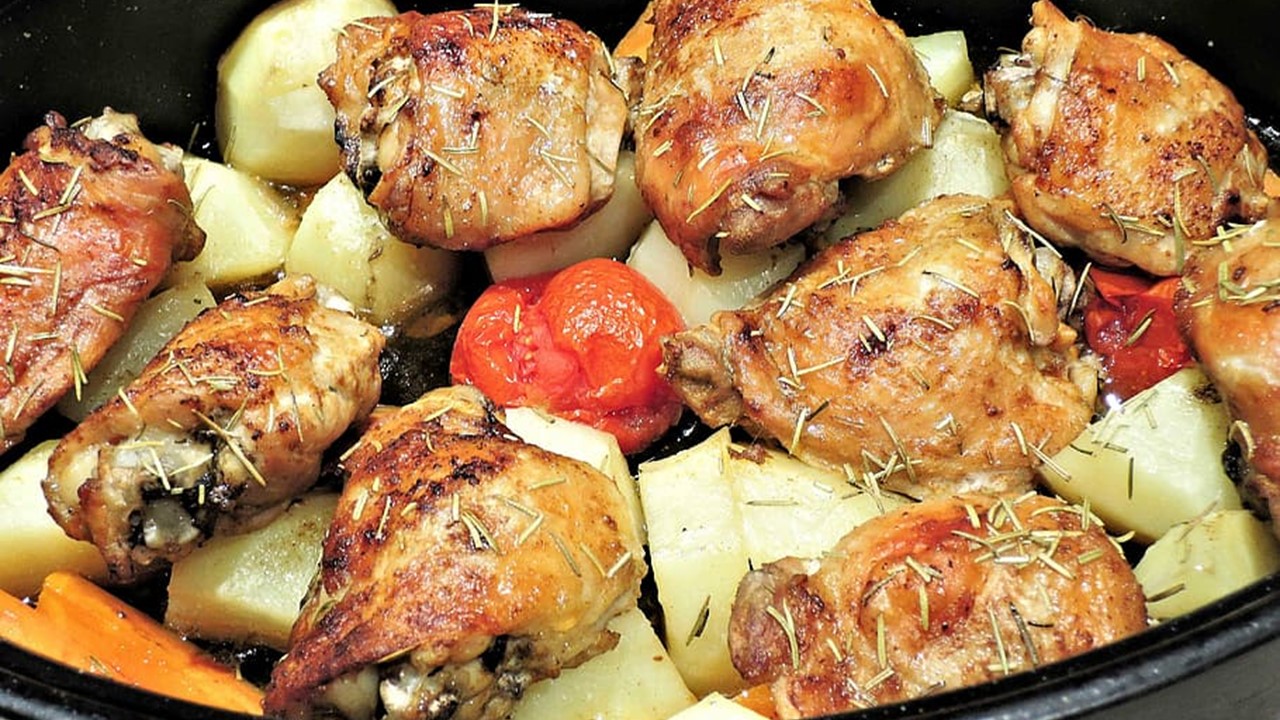
Roasting in the oven is one of the most delectable ways to cook meat, poultry, and veggies.
Though often overlooked, your trusted oven is a kitchen staple found in most homes, amidst all the fancy countertop appliances such as pressure cookers, air fryers, and slow cookers.
Roasting brings out the natural sweetness and flavor of food by utilizing its inherent sugars, resulting in a richer taste and improved texture.
It’s a hands-free cooking technique since the oven does all the work. While this method is suitable for veggies and fish, it’s best for meat cuts like chicken and pork.
Roasting allows food, particularly larger cuts, to cook evenly without the need for vigilant attention to an open flame. It also enhances the flavor of food, as demonstrated by Brussels sprouts.
Few would fancy boiled sprouts, but once roasted, they become irresistible. Roasting is the perfect way to cook meat slowly over a prolonged period, using dry heat to enclose the food, guaranteeing even heating throughout.
While roasting was once only done over an open flame, today it’s frequently done in an oven.
Roasting Vegetables
Due to the delicious, almost concentrated, sweet flavour that dry heat roasting imparts, roasting vegetables has become extremely popular.
Potatoes, cauliflower, broccoli, Brussels sprouts, and all varieties of root vegetables are dense vegetables that make excellent roasting candidates.
If they are occasionally turned and brushed with butter or olive oil to keep the cooking even on all sides, most vegetables can withstand roasting at temperatures between moderate and high heat very well.
But because the roasting times of many vegetables vary so much, try to keep the food you are roasting uniform in size and density, and use your eye to judge when it’s done.
Green vegetables should appear toasty and brown in spots, while potatoes and squash should be easy to pierce with the tip of a sharp knife.
There are some vegetables that roast well at lower temperatures. In the event that you are fortunate enough to have extra tomatoes, slow roasted tomatoes are a wonderful dish to make.
Small Roasts
Smaller cuts of meat, fish, and chicken may not be the best options for roasting because dry heat is involved.
The likelihood that they will dry out in the oven increases with their size.
Some of these cuts might be better off being seared in a pan first, then simply being “finished off” by a quick roast in the oven.
Duck breast, or pork chop, would all make excellent examples of this.
Hefty Roasts
For larger meat cuts like rib roasts, leg of lamb, and pork loins, roasting is a particularly good cooking technique.
Animals, Particularly Poultry
Chicken breasts can become dry if not carefully watched over, but poultry is also fantastic to roast.
When whole birds are cooked, the breast meat occasionally gets dry while the dark meat is still cooking.
When roasting a turkey or a chicken, many creative chefs turn the bird breast side down.
Others favour covering the breasts with aluminium foil around the midpoint of the cooking process.
In order to keep the bird juicy in this situation, basting is very helpful in redistributing the cooking juices onto the bird’s skin.
Fish
Because whole fish can be roasted, leaving the head on the fish helps it retain moisture and keeps it safe during cooking.
In order to add flavour and moisture, a whole fish can be packed in salt that is broken off before serving.
If the fish has already been butchered, filets can be covered with herbs and lemon slices or brushed with melted butter to maintain the delicate flesh’s tenderness.
Nuts
Nuts that have been shelled and are raw can be dried-roasted in the oven on a sheet tray, in a pan made of oven-safe metal, or both.
However, because they come in different sizes and toast at different rates, try to roast each nut variety separately before combining them in your recipe. For example, pine nuts are smaller than hazelnuts.
Additionally, keep a close eye on the oven and rotate the nuts periodically to ensure even toasting. There is probably no need to oil the pan because nuts contain a lot of oil already.
Types of Roasting
Larding
Larding is a cooking technique used to prepare large cuts of meat by weaving long strips of fat through the meat with the help of a larding needle. Usually, strips of rendered pork fatback are used for larding.
The process of larding adds flavour and helps the meat to retain moisture while cooking. It is commonly used for roasting meats, especially for leaner cuts of meat that could become dry if roasted without larding.
Barding
A technique for roasting lean meats or poultry by wrapping them in fat, such as bacon or fatback, to prevent them from drying out and absorbing extra moisture.
On lean cuts, which lack enough fat to stay moist and succulent, the barded fat bastes the meat while it roasts, adding flavour.
About 15 minutes before the meat is done cooking, the bard fat is removed to allow the meat to brown. Only when there is insufficient natural fat in the meat does barding become necessary.
Brining
When salt is applied to uncooked meat, whether by soaking in a water solution (wet brining) or by sprinkling salt on the meat (dry brining), the protein strands in the meat gradually break down, causing the meat to become more tender, take on flavours, and retain moisture.
This indicates that your meat will still be juicy even after roasting and a lengthy cooking period.
Basting
It is possible that basting the roast while it cooks is required when roasting meat.
Using pan drippings, stock, butter, or some other liquid, basting is a culinary technique for moistening the surface of roasted meat, poultry, or other foods.
In addition to adding moisture, basting gives the surface of the meat flavour (as long as the basting liquid has flavour).
Tips to Roast Better
Tempering Food
Tempering food is a straightforward but important process that entails bringing an ingredient to room temperature prior to cooking in order to improve the uniformity of the cooking process.
In order to ensure that meat cooks evenly and effectively, tempering is crucial when cooking most proteins, but it’s especially crucial when roasting large cuts of meat in the oven.
The meat will have a consistent temperature gradient from the centre to the edges thanks to the tempering process. A piece of meat that has been properly tempered should be completely at room temperature.
You might need a thermometer in some circumstances, like when cooking large cuts of meat, to ensure that the interior has been properly tempered.
In order to calibrate the oven, place an oven thermometer inside of it, turn it on, and when it has heated up completely, make sure the readings match.
Get an infrared thermometer to measure the actual temperature of your oven if it isn’t calibrated so you can achieve the proper temperature (even if the oven dial is off). You can also call a professional to adjust it if it isn’t calibrated.
Consider Your Equipment
A roasting pan or baking sheet will insulate meat or vegetables from the heat source, so you’ll need to rotate and flip the food at least once during the roasting process if you want it to cook evenly.
A whole chicken’s breast can be covered with aluminium foil to slow down cooking, or you can baste the skin with a liquid that is at room temperature.
The most accurate way to determine whether a roast is done is to check the internal temperature, which can be done with a meat thermometer or digital instant read thermometer.
Know Your Cuts
When roasting whole birds such as chickens or turkeys, it’s important to remember that the white and dark meat should be cooked to different temperatures for optimal taste and texture.
To achieve this, you can angle the bird’s various parts toward different areas of the oven with varying temperatures, or you can wrap foil around the breast to ensure even cooking.
Similarly, different cuts of red meat require different cooking conditions and temperatures for the best results.
Time
Roasted meat should be rested because it will continue to cook after you remove it from the oven due to carryover cooking. Usually, ten to twenty minutes are sufficient.
Combining Techniques and Temperatures
Try searing the meat in the pan and then roasting it slowly in the oven.
Sometimes it makes sense to start cooking food at a high temperature and then reduce the temperature as it cooks in order to achieve both caramelization and tenderness.
Size
Vegetables should be cut into pieces of the same size when roasting them to ensure even cooking.
Uses of Roasting in Indian Cuisine
The technique known as sekna is arguably one of the more intriguing and original methods used in Indian cuisine. Sekna, which literally translates to “the application of dry heat,” is a method of dry roasting that is widely used in everyday Indian cooking.
It aids in the maximum extraction of flavours from food. This dry roasting technique, which is otherwise used in specific culinary endeavours that are generally not relevant to everyday, common usage, allows for the cooking of everything from spices and condiments to rotis and papads.
“Aag mein Jalana” is one of the most distinctive techniques of Indian cooking because it is both a step in the cooking process and the cooking process itself. Examples adrak ki chatni, litti and chokha, baingan bharta etc.
“Pora” in Bengali is a method of cooking, but it does not always produce the desired outcome. Occasionally, ingredients are dry roasted before being ground to make mixes for dishes.
“Pora” is a very wholesome cooking method that is less common elsewhere. It is healthy in essence because there is no oil used in the entire cooking process, but it still produces food items that have a distinct flavour of their own.
Examples like Begun Pora, Lonka Pora, Aam Pora, Tomato Pora etc.
Conclusion
In order for the hot, dry air to transfer heat to the food instead of steam from the food, roasting calls for cooking the food in an open flame.
Indirect heat is used in baking and roasting, which allows food to be cooked fairly evenly across all of its surfaces.
This is different from pan-frying, for example, where the side that faces up and touches the hot pan becomes much hotter.

